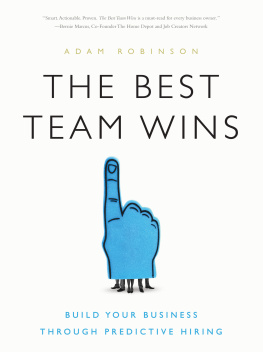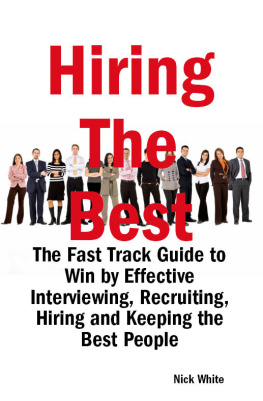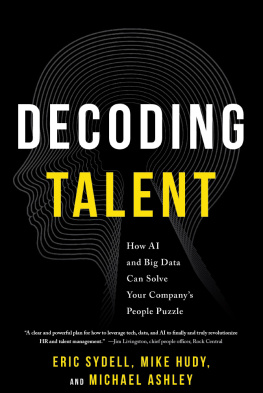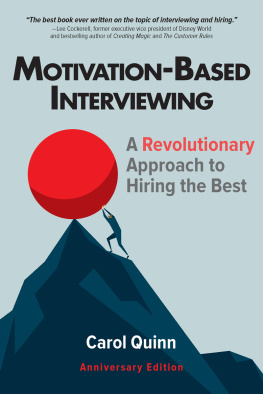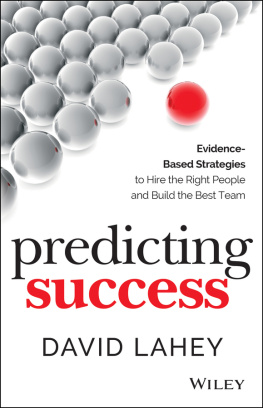ACKNOWLEDGMENTS
There are so many amazing individuals who contributed to this effort. Darren Dahl, my writing partner on this manuscript, made the case studies come alive and was instrumental in making sure the result was a great one. Christen Calloway, Hireologys Winston Wolf, kept me on track and focused, proofread and edited all the things, and managed the production schedule like the fate of the world depended on it. A big thank-you to Devin Law, whose illustrations so enhanced the quality of this book. To the crew at Greenleaf: thank you for believing in my vision for this book and helping bring it to reality.
The entrepreneurs and business leaders featured in this book gave their time, energy, and wisdom to this project and did so for no other reason than to be helpful and share their experience with the world. Thank you, all.
Most importantly, I want express my gratitude to my family, whose unwavering support makes everything I do possible.
And finally, a huge high five shout-out to the entire team at Hireology, who prove every day that the best team does, in fact, win. (Own it!)
ABOUT THE AUTHOR
Adam Robinson is the cofounder and CEO of Hireology (www.Hireology.com), where hes on a mission to help business owners make better hiring decisions using predictive data and innovative technology. He is a noted recruiting industry expert, speaker, and author with over twenty years of experience in the field of hiring and selection management.
In 2016, Robinson was named to the Chicago Tech50 list of the citys top technology entrepreneurs by Crains Chicago Business. Robinson was added to the Chicago Tribunes Blue Network, a listing of Chicagos most influential entrepreneurs and innovators, and named a Top 25 HR Industry Game Changer Under 40 in 2015 by Workforce magazine. Under his leadership, Hireology was named #94 on the 2016 Inc. 500 list, and has been recognized nationally by Entrepreneur magazine as a Top Company Culture and by Crains Chicago Business as a Best Places to Work for both Millennials and Gen X. Hireology was named the #1 Talent Management Platform in 2014, 2015, and 2016 and #1 in Customer Service in 2013, 2014, 2015, and 2016 by Human Resources Online magazine.
Adam is passionate about entrepreneurship, donating time to a number of organizations that support the entrepreneurial cause. Through multiple leadership roles at Entrepreneurs Organization (www.eonetwork.org), he has helped to develop and launch programs that teach core business skills to early-stage entrepreneurs around the world.
Adam has a BA from the University of Illinois at Urbana-Champaign, and received his MBA from DePaul University. Hes a member of the Economic Club of Chicago.
Chapter One
DISCOVER YOUR UNTAPPED COMPETITIVE ADVANTAGE
When you distill business to its basic element, youre left with one thing: people. No matter what product or service youre offeringselling cars, renting hotel rooms, manufacturing 3D printers, or providing digital marketing servicesits the people working in your business that make things happen. Theyre the faces that your customers see on a daily basis. In todays hypercompetitive world, where your competitors can copy even the most innovative new offerings in near real time, its your people that are the true secret. Good people clear the field and drive success. They are the one truly unique competitive advantage left for your business to pursue.
Even though payroll is one of the largest expenses for a business, most businesses have woefully inadequate processes to ensure that the right people get hired. People account for around 70 percent of the cost structure of a typical company; think of your people as stacks of cash walking around in shoes. When a manager makes a bad hire, an employee can end up costing the company even moreup to ten times a typical employees compensation, by some estimates. Why is the financial damage of a poor hiring decision so high? Bad hires result in the following costs:
- Disruption to your company culture that negatively influences your other employees
- Loss of essential management time and focus because of turnover and recruiting
- Damage to your companys reputation, which affects your customers and future potential employees
- Wasted wages and training costs
Despite these high stakes, most managers report that nearly 50 percent of the people who report to them fail to meet performance expectations, a problem that often occurs when employees do not understand how their performance is measured. With results like these, why even bother with a hiring process or job interviews? Why not just flip a coin, hire all the heads, and save yourself the trouble? If good people are so crucial to the success of your business, isnt it about time to even those odds by rethinking how you might go about hiring them?
Finding qualified candidates is harder than ever.
Labor shortages in crucial functional areas such as technology, sales, and marketing are making it all but impossible for companies to meet their talent needs solely with traditional recruiting techniques like job postingsa trend we expect to intensify, given the growth of the worldwide knowledge economy, says Corey Greendale, a technology venture capitalist and analyst with the firm First Analysis.
The global economic recovery is shifting power from employers to employees with high-demand skills and increasingly turning labor into a sellers market.
Greendale also notes that demographics are likely to exacerbate this trend, with the Bureau of Labor Statistics projecting that US workers aged sixteen to twenty-four will shrink 13.3 percent in the decade ending 2022.
FIG 1.1SIZE OF ENTRY LEVEL US LABOR FORCE
(IN THOUSANDS)

Business leaders worldwide increasingly recognize that talent will be a key competitive consideration over the coming years, says Greendale. HR systems and structures are often insufficient to address the looming challenges.
The 2013 Conference Board CEO Challenge report, a survey of seven hundred CEOs from around the globe, identified human capital as the number one challenge facing them today, above factors such as operational excellence (number two) and customer relationships (number four).
We view these results as a signal that human capital is shifting from a seat filling function to a core strategic consideration and will increasingly occupy the attention of high-level corporate decision makers, says Greendale.
Getting the right people in your organization isnt someone elses job anymore: Its time for you to own it.
Case Study: People Make the Difference
David Barr has seen it all when it comes to running retail and restaurant businesses. He has advice for business owners and hiring managers: Its time to rethink your hiring practices. The factor that sets any business apart from its competitors is its people.
Hiring the right people is the number one thing we do in retail, says Barr, whose holding company is called PMTD (People Make the Difference). Our people are the most crucial factor to our success. It doesnt matter whether we sell burgers, chicken, or jewelry. We will win every time if we have the best people. They are the representation of our brand and the interface with our customers.
Given his extensive experience as a business owner and advisor, Barr has been asked to brief White House policymakers, senators, and members of Congress and their staffs on how different policies like the Affordable Care Act (ACA) influence the retail industry. The retail industry employs more than fifteen million people in the US,which means about one in ten people in the workforce are employed in the retail sectormore than any other market segment except government and healthcare.
Next page
